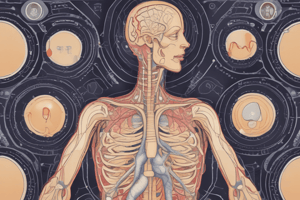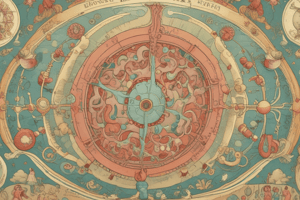Podcast
Questions and Answers
How does the endocrine system act on the body?
How does the endocrine system act on the body?
- Through a combination of both electrical impulses and chemical messengers
- Through chemical messengers called hormones (correct)
- Through electrical impulses and neurotransmitters
Which of the following is NOT a function of the endocrine system?
Which of the following is NOT a function of the endocrine system?
- Muscle contraction (correct)
- Regulation of body activities
- Coordination of functioning between different organs
- Influence on growth and development
The endocrine system coordinates functioning between different organs through ___.
The endocrine system coordinates functioning between different organs through ___.
- neurotransmitters
- hormones (correct)
- electrical impulses
The endocrine system's effects are typically of short duration, measured in seconds and localized.
The endocrine system's effects are typically of short duration, measured in seconds and localized.
What are the three main types of hormones?
What are the three main types of hormones?
What is the name of the complex that can be thought of as the "command center" of the endocrine system?
What is the name of the complex that can be thought of as the "command center" of the endocrine system?
Match the following terms with their definitions:
Match the following terms with their definitions:
What is the name of the hormone that regulates mineral balance?
What is the name of the hormone that regulates mineral balance?
What are the two main hormones secreted by the pancreas?
What are the two main hormones secreted by the pancreas?
The thyroid gland is a paired gland located in the neck.
The thyroid gland is a paired gland located in the neck.
The parathyroid glands are typically four in number, are small, and located on the anterior surface of the thyroid gland.
The parathyroid glands are typically four in number, are small, and located on the anterior surface of the thyroid gland.
What is the name of the condition where the body produces insufficient growth hormone?
What is the name of the condition where the body produces insufficient growth hormone?
What are the two syndromes of excessive secretion of growth hormone?
What are the two syndromes of excessive secretion of growth hormone?
What is the name of the condition where there is a deficiency of parathyroid hormone?
What is the name of the condition where there is a deficiency of parathyroid hormone?
The adrenal glands are located on top of the kidneys.
The adrenal glands are located on top of the kidneys.
Pheochromocytoma is a tumor that is typically located in the adrenal cortex.
Pheochromocytoma is a tumor that is typically located in the adrenal cortex.
What is the name of the duct that joins the pancreatic duct to form the hepatopancreatic ampulla?
What is the name of the duct that joins the pancreatic duct to form the hepatopancreatic ampulla?
The testes are located within the pelvis.
The testes are located within the pelvis.
What is the name of the hormone that is produced by the testes and stimulates the development of male secondary sex characteristics?
What is the name of the hormone that is produced by the testes and stimulates the development of male secondary sex characteristics?
The ovaries are located on the anterior surface of the uterus
The ovaries are located on the anterior surface of the uterus
Which of the following is NOT a function of the ovaries?
Which of the following is NOT a function of the ovaries?
Flashcards
Endocrine System
Endocrine System
A system of glands that produce hormones to regulate body activities.
Hormones
Hormones
Chemical messengers that influence growth, development, and metabolic activities.
Target Organs
Target Organs
Organs affected by hormones.
Nervous System
Nervous System
Signup and view all the flashcards
Hypothalamus-Pituitary Complex
Hypothalamus-Pituitary Complex
Signup and view all the flashcards
Hypothalamus
Hypothalamus
Signup and view all the flashcards
Pituitary Gland
Pituitary Gland
Signup and view all the flashcards
Paracrine Effect
Paracrine Effect
Signup and view all the flashcards
Autocrine Effect
Autocrine Effect
Signup and view all the flashcards
Infundibulum
Infundibulum
Signup and view all the flashcards
Sella Turcica
Sella Turcica
Signup and view all the flashcards
Diencephalon
Diencephalon
Signup and view all the flashcards
Endocrine Glands
Endocrine Glands
Signup and view all the flashcards
Chemical Messengers
Chemical Messengers
Signup and view all the flashcards
Short duration effect
Short duration effect
Signup and view all the flashcards
Long duration effect
Long duration effect
Signup and view all the flashcards
Neurotransmitters
Neurotransmitters
Signup and view all the flashcards
Peptides
Peptides
Signup and view all the flashcards
Steroids
Steroids
Signup and view all the flashcards
Amino acid derivatives
Amino acid derivatives
Signup and view all the flashcards
Neuroendocrine
Neuroendocrine
Signup and view all the flashcards
General action
General action
Signup and view all the flashcards
Localized Action
Localized Action
Signup and view all the flashcards
Study Notes
Endocrine System Overview
- The endocrine system works with the nervous system to regulate body functions.
- The nervous system uses electrical impulses and neurotransmitters for rapid, localized effects (seconds).
- The endocrine system uses hormones to influence growth, development, and metabolism; effects last longer (minutes to weeks).
Endocrine Glands vs. Exocrine Glands
- Exocrine glands have ducts that carry secretions to the body surface or cavities.
- Examples include tear glands, sweat glands, and mammary glands.
- Endocrine glands lack ducts and release hormones directly into the bloodstream.
- Examples include glands that produce hormones for blood sugar regulation.
Hypothalamus-Pituitary Complex
- This is the "command center", regulating other endocrine glands' hormone production.
- The hypothalamus is a brain region; the pituitary is a gland connected to the hypothalamus by the infundibulum.
- The pituitary has two lobes (anterior and posterior), with different origins and functions.
- The anterior pituitary is a glandular tissue, regulated by releasing hormones from the hypothalamus via the hypophyseal portal system (network of blood vessels).
- The posterior pituitary is neural tissue, storing and releasing hormones made in the hypothalamus; Oxytocin and ADH.
Anterior Pituitary Hormones
- Hormones from the anterior pituitary target different organs with specific effects.
- Growth hormone (GH) affects growth.
- Prolactin stimulates milk production.
- Adrenocorticotropic hormone (ACTH) targets the adrenal cortex.
- Thyroid-stimulating hormone (TSH) targets the thyroid.
- Follicle-stimulating hormone (FSH) and luteinizing hormone (LH) target the reproductive system.
Posterior Pituitary Hormones
- The posterior pituitary stores and releases hormones made by the hypothalamus, namely:
- Antidiuretic hormone (ADH) regulates water balance.
- Oxytocin triggers uterine contractions and milk production.
Pituitary Lesions
- Hypersecretion (hyperpituitarism) often results in selective excess of hormones, like growth hormone.
- Hyposecretion (hypopituitarism) can be selective or generalized.
Gigantism and Acromegaly
- Excessive growth hormone (GH) secretion.
- Gigantism in childhood, before epiphyseal closure affects overall bone and height growth.
- Acromegaly in adults, after epiphyseal closure affects soft tissue growth and bone thickening.
Growth Hormone Deficiency
- Insufficient growth hormone production resulting in stunted growth in children and delayed puberty.
Galactorrhea
- Inappropriate lactation (milk production).
- Often linked to prolactin-secreting pituitary tumors.
Hyperthyroidism (Thyrotoxicosis)
- Overproduction of thyroid hormones.
- Symptoms mimic adrenergic excess.
- Common causes: Graves disease, thyroiditis.
Hypothyroidism
- Underproduction of thyroid hormones.
- Symptoms include fatigue, cold intolerance, weight gain, and slowed metabolism.
Cretinism
- Congenital hypothyroidism, causing severe physical and mental retardation, typically diagnosed during infant screening.
Parathyroid Glands
- Regulate calcium levels in the blood.
- Parathyroid hormone (PTH) increases blood calcium.
- Calcium is crucial to many body processes.
Simple Non-Toxic Goiter
- Enlargement of the thyroid gland without a functional problem.
- Often due to iodine deficiency, but not always.
Adrenal Glands
- Located atop the kidneys.
- Adrenal cortex releases steroid hormones (cortisol, aldosterone).
-Cortisol regulates glucose metabolism.
- Aldosterone regulates mineral balance
- Adrenal medulla produces epinephrine (adrenaline) and norepinephrine, stress hormones.
Pheochromocytoma
- Adrenal medulla tumor, secreting excess catecholamines, causing extreme hypertension.
Pancreas
- A mixed gland: exocrine (digestive enzymes) and endocrine (insulin and glucagon).
- Exocrine function involves acinar cells secreting digestive enzymes into the pancreatic duct.
- Endocrine function involves pancreatic islets (islets of Langerhans) secreting insulin and glucagon to regulate blood sugar.
Testes
- Male gonads responsible for producing sperm and androgens (testosterone)
Ovaries
- Female gonads, producing eggs and the female sex hormones estrogen and progesterone.
Studying That Suits You
Use AI to generate personalized quizzes and flashcards to suit your learning preferences.




